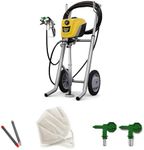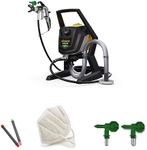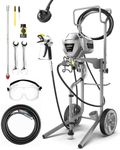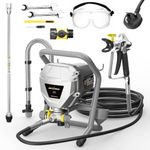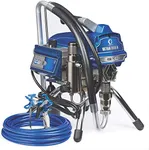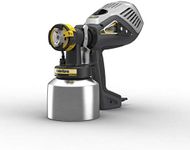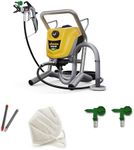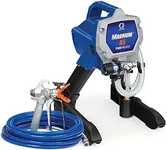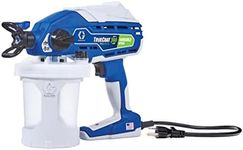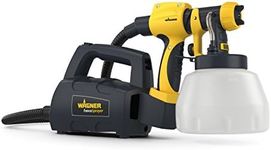Buying Guide for the Best Airless Paint Sprayers
Choosing the right airless paint sprayer can make your painting projects more efficient and provide a professional finish. Airless paint sprayers are ideal for large surfaces and can handle a variety of paint types, making them versatile tools for both DIY enthusiasts and professionals. When selecting an airless paint sprayer, consider the type of projects you will be undertaking, the frequency of use, and the types of materials you will be spraying. Understanding the key specifications will help you make an informed decision that best suits your needs.Pressure RatingThe pressure rating of an airless paint sprayer indicates the force at which the paint is expelled from the sprayer. This is important because higher pressure allows for faster application and better atomization of the paint, resulting in a smoother finish. Pressure ratings are typically measured in PSI (pounds per square inch). For small projects or touch-ups, a lower pressure rating (around 1500-2000 PSI) may suffice. For larger projects or thicker materials, a higher pressure rating (2500-3000 PSI or more) is recommended. Consider the size and scope of your projects to determine the appropriate pressure rating for your needs.
Flow RateThe flow rate of an airless paint sprayer, measured in gallons per minute (GPM), indicates how much paint the sprayer can apply in a given time. This is crucial for determining how quickly you can complete a project. A higher flow rate means faster coverage, which is beneficial for large areas. For small to medium projects, a flow rate of 0.25 to 0.5 GPM may be adequate. For larger projects, look for a sprayer with a flow rate of 0.5 GPM or higher. Choose a flow rate that matches the scale of your projects to ensure efficiency and effectiveness.
Tip SizeThe tip size of an airless paint sprayer determines the width and thickness of the spray pattern. This is important because different materials and surfaces require different tip sizes for optimal application. Tip sizes are usually indicated by a three-digit number, where the first digit represents half the fan width in inches, and the last two digits represent the orifice size in thousandths of an inch. For thin materials like stains or lacquers, a smaller tip size (e.g., 0.009-0.013) is suitable. For thicker materials like latex paints, a larger tip size (e.g., 0.015-0.021) is recommended. Consider the types of materials you will be using to select the appropriate tip size.
Hose LengthThe hose length of an airless paint sprayer affects your mobility and reach during a project. A longer hose allows you to move freely around large areas without having to frequently reposition the sprayer unit. Hose lengths can vary from 25 feet to over 100 feet. For small projects or confined spaces, a shorter hose may be sufficient. For larger projects or when working on multi-story buildings, a longer hose is beneficial. Choose a hose length that provides the flexibility and reach you need for your specific projects.
Motor PowerThe motor power of an airless paint sprayer, measured in horsepower (HP), determines the sprayer's ability to handle thicker materials and maintain consistent pressure. This is important for ensuring a smooth and even application. For light-duty projects or occasional use, a motor with lower horsepower (around 0.5 HP) may be adequate. For heavy-duty projects or frequent use, a more powerful motor (1 HP or more) is recommended. Consider the types of materials you will be spraying and the frequency of use to select the appropriate motor power.
